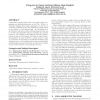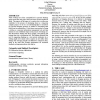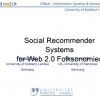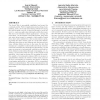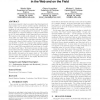HT
2009
ACM
14 years 6 months ago
2009
ACM
Collaborative tagging systems are now popular tools for organising and sharing information on the Web. While collaborative tagging offers many advantages over the use of controll...
HT
2009
ACM
14 years 6 months ago
2009
ACM
While weblogs have been conceptualised as personal thinking spaces since their early days, those uses have not been studied in detail. The purpose of this paper is to explore how ...
HT
2009
ACM
14 years 6 months ago
2009
ACM
This paper proposes an approach to comparison of spatial hypertext collections which avoids becoming entangled in complexities of version management and merging. We also propose a...
HT
2009
ACM
14 years 6 months ago
2009
ACM
HT
2009
ACM
14 years 6 months ago
2009
ACM
Data created by social bookmarking systems can be described as 3-partite 3-uniform hypergraphs connecting documents, users, and tags (tagging networks), such that the toolbox of c...
HT
2009
ACM
14 years 6 months ago
2009
ACM
In this paper we present ArsMeteo◦ , a Web 2.0 portal for collecting and sharing digital (or digitalized) artworks, like videos, pictures, poems and music. The ArsMeteo◦ conte...
HT
2009
ACM
14 years 6 months ago
2009
ACM
The Social Web is successfully established and poised for continued growth. Web 2.0 applications such as blogs, bookmarking, music, photo and video sharing systems are among the m...
HT
2009
ACM
14 years 6 months ago
2009
ACM
Most evaluations of web-based information systems are done with respect to their effectiveness in supporting users in finding and exploring the information they need. We believe (...
HT
2009
ACM
14 years 6 months ago
2009
ACM
In previous research it has been shown that link-based web page metrics can be used to predict experts’ assessment of quality. We are interested in a related question: do expert...
HT
2009
ACM
14 years 6 months ago
2009
ACM
The early Web was hailed for being easy to use, and what is more important, giving people a chance to participate in its growth. The Web3D was believed to have potential to be the...
